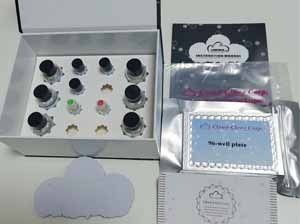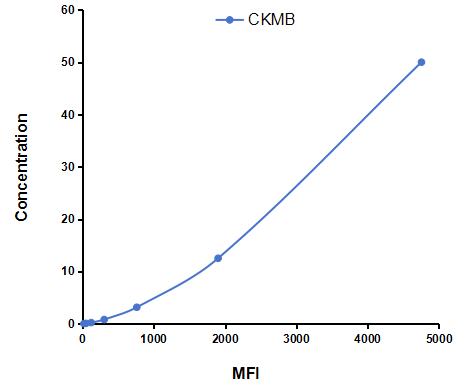Multiplex Assay Kit for Creatine Kinase MB Isoenzyme (CKMB) ,etc. by FLIA (Flow Luminescence Immunoassay) 

CK2; CK-MB; Creatine Kinase,Muscle/Brain
(Note: Up to 8-plex in one testing reaction)
- UOM
- FOB US$ 359.00 US$ 373.00 US$ 394.00 US$ 422.00 US$ 449.00 US$ 491.00 US$ 553.00 US$ 691.00
- Quantity
Overview
Properties
- Product No.LMA479Mu
- Organism SpeciesMus musculus (Mouse) Same name, Different species.
- ApplicationsFLIA Kit for Antigen Detection.
Research use only - DownloadInstruction Manual
- CategoryEnzyme & KinaseCardiovascular biology
Sign into your account
Share a new citation as an author
Upload your experimental result
Review

Contact us
Please fill in the blank.
Recovery
Matrices listed below were spiked with certain level of recombinant Creatine Kinase MB Isoenzyme (CKMB) ,etc. by FLIA (Flow Luminescence Immunoassay) and the recovery rates were calculated by comparing the measured value to the expected amount of Creatine Kinase MB Isoenzyme (CKMB) ,etc. by FLIA (Flow Luminescence Immunoassay) in samples.
| Matrix | Recovery range (%) | Average(%) |
| serum(n=5) | 81-103 | 92 |
| EDTA plasma(n=5) | 80-92 | 88 |
| heparin plasma(n=5) | 92-101 | 96 |
| sodium citrate plasma(n=5) | 90-98 | 95 |
Precision
Intra-assay Precision (Precision within an assay): 3 samples with low, middle and high level Creatine Kinase MB Isoenzyme (CKMB) ,etc. by FLIA (Flow Luminescence Immunoassay) were tested 20 times on one plate, respectively.
Inter-assay Precision (Precision between assays): 3 samples with low, middle and high level Creatine Kinase MB Isoenzyme (CKMB) ,etc. by FLIA (Flow Luminescence Immunoassay) were tested on 3 different plates, 8 replicates in each plate.
CV(%) = SD/meanX100
Intra-Assay: CV<10%
Inter-Assay: CV<12%
Linearity
The linearity of the kit was assayed by testing samples spiked with appropriate concentration of Creatine Kinase MB Isoenzyme (CKMB) ,etc. by FLIA (Flow Luminescence Immunoassay) and their serial dilutions. The results were demonstrated by the percentage of calculated concentration to the expected.
| Sample | 1:2 | 1:4 | 1:8 | 1:16 |
| serum(n=5) | 80-93% | 86-99% | 97-105% | 90-98% |
| EDTA plasma(n=5) | 78-91% | 88-101% | 89-97% | 86-94% |
| heparin plasma(n=5) | 78-101% | 78-91% | 99-105% | 78-95% |
| sodium citrate plasma(n=5) | 92-101% | 80-104% | 86-95% | 91-99% |
Stability
The stability of kit is determined by the loss rate of activity. The loss rate of this kit is less than 5% within the expiration date under appropriate storage condition.
To minimize extra influence on the performance, operation procedures and lab conditions, especially room temperature, air humidity, incubator temperature should be strictly controlled. It is also strongly suggested that the whole assay is performed by the same operator from the beginning to the end.
Reagents and materials provided
| Reagents | Quantity | Reagents | Quantity |
| 96-well plate | 1 | Plate sealer for 96 wells | 4 |
| Pre-Mixed Standard | 2 | Standard Diluent | 1×20mL |
| Pre-Mixed Magnetic beads (22#:CKMB) | 1 | Analysis buffer | 1×20mL |
| Pre-Mixed Detection Reagent A | 1×120μL | Assay Diluent A | 1×12mL |
| Detection Reagent B (PE-SA) | 1×120μL | Assay Diluent B | 1×12mL |
| Sheath Fluid | 1×10mL | Wash Buffer (30 × concentrate) | 1×20mL |
| Instruction manual | 1 |
Assay procedure summary
1. Preparation of standards, reagents and samples before the experiment;
2. Add 100μL standard or sample to each well,
add 10μL magnetic beads, and incubate 90min at 37°C on shaker;
3. Remove liquid on magnetic frame, add 100μL prepared Detection Reagent A. Incubate 60min at 37°C on shaker;
4. Wash plate on magnetic frame for three times;
5. Add 100μL prepared Detection Reagent B, and incubate 30 min at 37°C on shaker;
6. Wash plate on magnetic frame for three times;
7. Add 100μL sheath solution, swirl for 2 minutes, read on the machine.

Test principle
Analyte-specific antibodies are pre-coated onto color-coded microparticles. Microparticles, standards, and samples are pipetted into wells and the immobilized antibodies bind the analytes of interest. After washing away any unbound substances, a biotinylated antibody cocktail specific to the analytes of interest is added to each well. Following a wash to remove any unbound biotinylated antibody, Streptavidin-Phycoerythrin conjugate (Streptavidin-PE), which binds to the biotinylated detection antibodies, is added to each well. A final wash removes unbound Streptavidin-PE and the microparticles are resuspended in buffer and read using the Luminex or Bio-Plex analyzer.The MFI developed is proportional to the concentration of analytes of interest in the sample.
Giveaways
Increment services
Citations
- Aldehyde Dehydrogenase-2 Activation during Cardioplegic Arrest Enhances the Cardioprotection against Myocardial Ischemia–Reperfusion InjuryPubMed: 22814936
- N-Acetylcysteine and Allopurinol Confer Synergy in Attenuating Myocardial Ischemia Injury via Restoring HIF-1α/HO-1 Signaling in Diabetic RatsPubMed: PMC3715528
- Effects of morphine and sufentanil preconditioning against myocardial ischemic-reperfusion injury in rabbitsPubMed: 26629064
- Diabetes blocks the cardioprotective effects of sevoflurane postconditioning by impairing Nrf2/Brg1/HO-1 signalingPubmed:26973173
- Effect of levocarnitine on TIMP-1, ICAM-1 expression of rats with coronary heart disease and its myocardial protection effectPubmed:26972400
- Circulating miR-126 and miR-499 reflect progression of cardiovascular disease; correlations with uric acid and ejection fractionpubmed:27924211
- Peroxisome proliferator-activated receptor γ (PPARγ) mediates the protective effect of quercetin against myocardial ischemia-reperfusion injury via …PMC5209473
- In Vivo Cardioprotective Effects and Pharmacokinetic Profile of N-Propyl Caffeamide AgainstIschemia Reperfusion Injury.pubmed:27480649
- Cardiac biomarkers in dogs with visceral leishmaniasisS0301-732X2016000300004
- Remote Limb Ischaemic Postconditioning Protects Against Myocardial Ischaemia/ Reperfusion Injury in Mice: Activation of JAK/STAT3-Mediated Nrf2-Antioxidant Signalling10.1159:481755
- Morinda Citrifolia (Noni) and Low Dose Aspirin Prevent Apoptotic Cell Death and Oxidative Stress on Isoproterenol Induced Myocardial Infarction in RatsDOI: 10.5152/etd.2017.1732
- Metformin attenuated endotoxin-induced acute myocarditis via activating AMPKpubmed:28410530
- Co-exposure of silica nanoparticles and methylmercury induced cardiac toxicity andPubmed:29727991
- GYY4137 protects against myocardial ischemia/reperfusion injury via activation of the PHLPP-1/Akt/Nrf2 signaling pathway in diabetic micePubmed:29605032
- Hydrogen‑rich solution against myocardial injury and aquaporin expression via the PI3K/Akt signaling pathway during cardiopulmonary bypass in ratsPubmed:29956781
- Cyclic helix B peptide ameliorates acute myocardial infarction in mice by inhibiting apoptosis and inflammatory responses
- Adiponectin Facilitates Postconditioning Cardioprotection through Both AMPK-Dependent Nuclear and AMPK-Independent Mitochondrial STAT3 ActivationPubmed: 32190173
- Tissue suction-mediated gene transfer to the beating heart in micePubmed: 32027678
- Deletion of Rap1 protects against myocardial ischemia/reperfusion injury through suppressing cell apoptosis via activation of STAT3 signalingPubmed: 32020680
- Differentially expressed lncRNAs, miRNAs and mRNAs with associated ceRNA networks in a mouse model of myocardial ischemia/reperfusion injuryPubmed: 32705277
- Hydrogen sulphide and nitric oxide cooperate in cardioprotection against ischemia/reperfusion injury in isolated rat heartPubmed: 32871779
- Melatonin Attenuates Anoxia/Reoxygenation Injury by Inhibiting Excessive Mitophagy Through the MT2/SIRT3/FoxO3a Signaling Pathway in H9c2 CellsPubmed: 32546969
- Biological Safety and Biodistribution of Chitosan NanoparticlesPubmed: 32340313
- The mRNA expression of Il6 and Pdcd1 are predictive and protective factors for doxorubicin?induced cardiotoxicity33300057
- Inactivation of TOPK Caused by Hyperglycemia Blocks Diabetic Heart Sensitivity to Sevoflurane Postconditioning by Impairing the PTEN/PI3K/Akt Signaling33986917
- Long non-coding RNA MALAT1 modulates myocardial ischemia-reperfusion injury though the PI3K/Akt/eNOS pathway by sponging miRNA-133a-3p to target IGF1R …Pubmed:34968461
- Hyperglycemia-Induced Overexpression of PH Domain Leucine-Rich Repeat Protein Phosphatase 1 (PHLPP1) Compromises the Cardioprotective Effect of Ischemic …Pubmed:35715527
- Mokko Lactone Alleviates Doxorubicin-Induced Cardiotoxicity in Rats via Antioxidant, Anti-Inflammatory, and Antiapoptotic Activities. Nutrients 2022, 14, 733Pubmed:35215383
- Hydrogen therapy after resuscitation improves myocardial injury involving inhibition of autophagy in an asphyxial rat model of cardiac arrestPubmed:35495584
- MicroRNA-503 Exacerbates Myocardial Ischemia/Reperfusion Injury via Inhibiting PI3K/Akt-and STAT3-Dependent Prosurvival Signaling PathwaysPubmed:35620576
- Vitamin E Attenuates Cardiomyopathy Via Alleviation of Autophagic Stress







